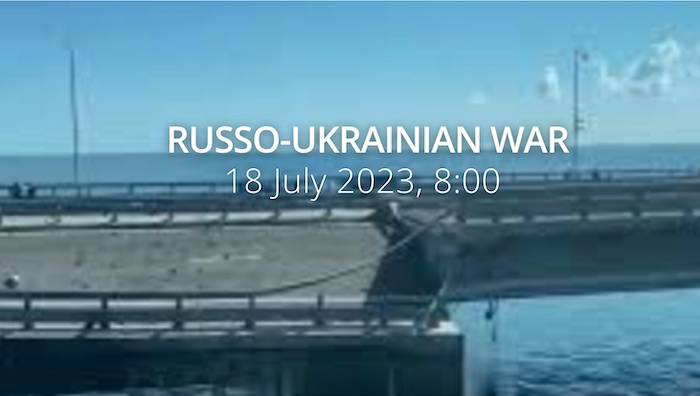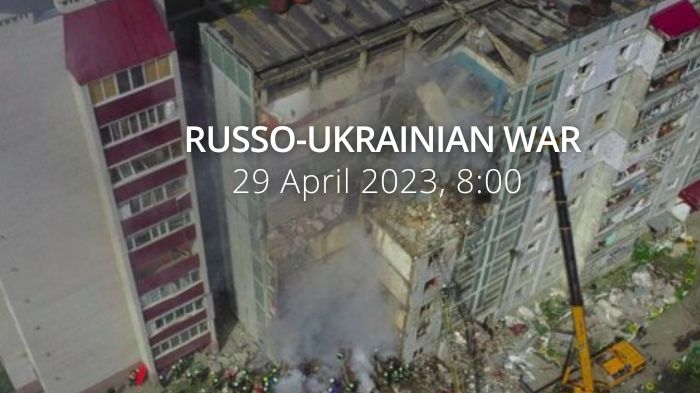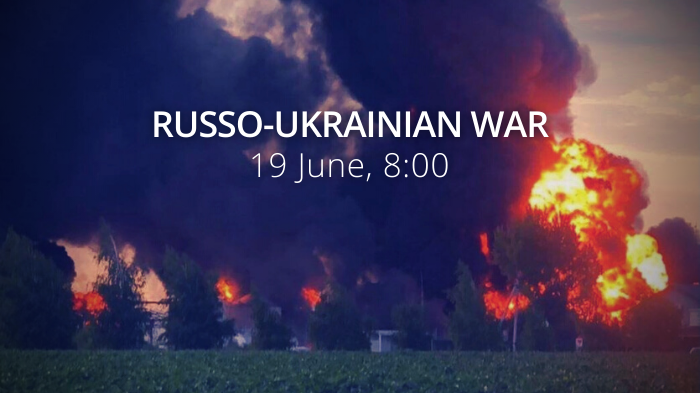Britain rejects Russia's accusation of UK's possible involvement in the Crimean bridge attack. Russians are withdrawing reserves to Bakhmut in order to maintain their positions. 200 children to be evacuated from Kharkiv Oblast due to danger.
Daily overview — Summary report, July 18
The General Staff’s operational update regarding the Russian invasion as of 18.00 pm, July 18, 2023 is in the dropdown menu below:

- Volyn and Polissya axes: no significant changes.
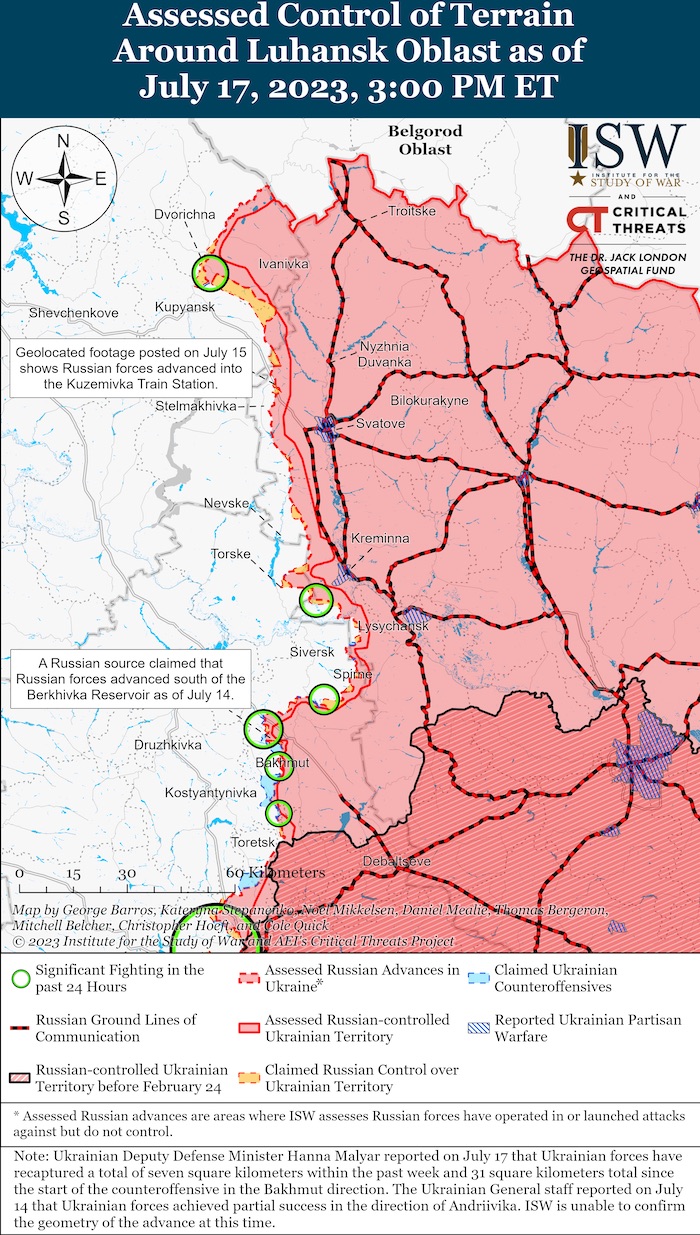
- Sivershchyna and Slobozhanshchyna axes: the adversary continues to maintain its military presence. Russian forces launched an airstrike in the vicinity of Bilopillya (Sumy oblast). The invaders fired mortars and artillery at more than 30 settlements, including Chuikivka, Boyaro-Lezhachi, Iskryskivshchyna, Pavlivka (Sumy oblast), Vovchans’k, Karaichne, and Budarky (Kharkiv oblast).
- Kupiansk axis: the Ukrainian troops are standing their ground. On July 17, the adversary conducted unsuccessful offensives west of Lyman Pershyi (Kharkiv oblast). The invaders launched airstrikes in the vicinities of Kyslivka and Kotlyarivka. Novomlyns’k, Dvorichna, Zapadne, Kupiansk, and Kyslivka (Kharkiv oblast) came under artillery and mortar fire from the adversary.
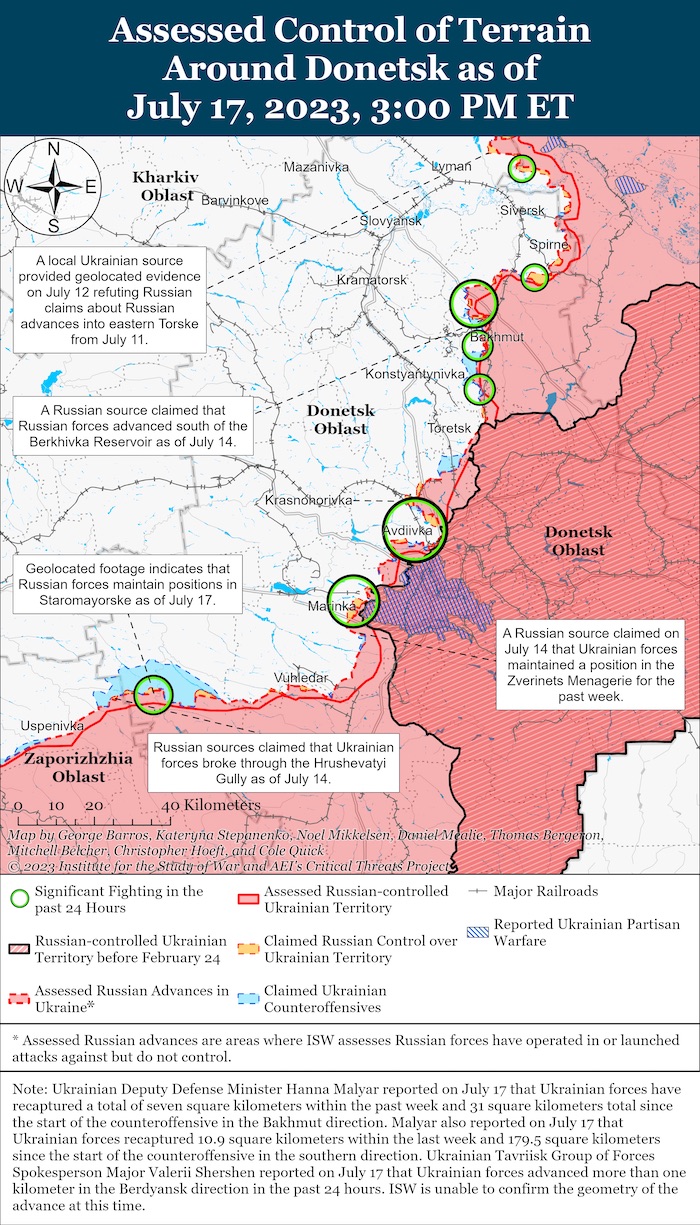
- Lyman axis: On July 17, the adversary conducted unsuccessful offensives in the area west of Dibrova and east of Vesele (Luhansk oblast). The invaders launched airstrikes in the vicinities of Bilohorivka (Luhansk Oblast), Terny, and Spirne (Donetsk Oblast). The settlements of Nevske, Bilohorivka (Luhansk oblast), Tors’ke, Verkhn’okam’yans’ke, Spirne, Berestove, and Rozdolivka Donetsk oblast oblast) were shelled with artillery.
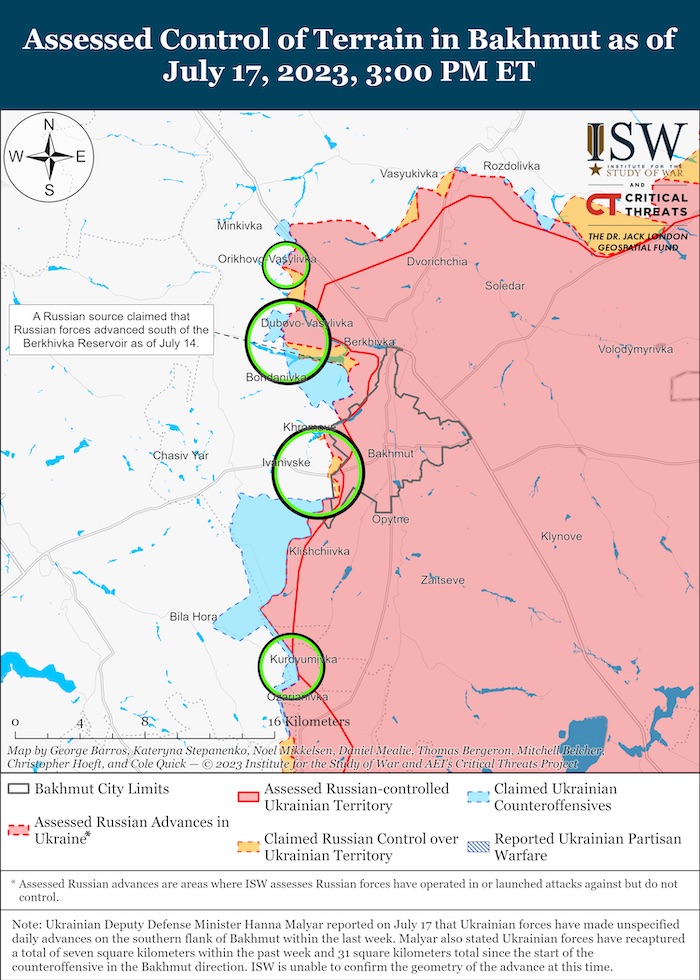
- Bakhmut axis: under heavy fire from enemy aircraft and artillery, the Ukrainian defenders successfully repelled enemy attacks in the vicinities of Min’kivka, southeast of Orikhovo-Vasylivka, southeast of Bohdanivka, and near Ivanivske (Donetsk oblast). The enemy launched airstrikes in the vicinities of Bohdanivka and Oleksandro-Shul’tyne. More than 15 settlements, including Kramatorsk, Kostyantynivka, Chasiv Yar, Pleshchiivka, Oleksandro-Shul’tyne, Dyliivka, Pivnichne, and Katerynivka (Donetsk oblast), suffered from enemy artillery shelling.
- Avdiivka axis: under enemy aircraft fire, Ukrainian defenders repelled all attacks in the vicinity of the city of Avdiivka (Donetsk oblast). At the same time, the enemy fired artillery at more than 15 settlements, including Novoandriivka, Novobakhmutivka, Keramik, Avdiivka, Nevelske, and Karlivka (Donetsk oblast).
- Marinka axis: the Ukrainian Defence Forces successfully continue to hold back the Russian offensive in the vicinity of the city of Marinka and near Krasnohorivka. The adversary shelled more than 10 settlements, including Krasnohorivka, Marinka, Hostre, Veselyi Hai, and Novomykhailivka (Donetsk oblast).
- Shakhtarske axis: the enemy launched airstrikes in the vicinities of Makarivka, Blahodatne, Novodarivka, and Komar (Donetsk oblast). The invaders shelled the settlements of Blahodatne, Vuhledar, Prechystivka, Neskuchne, Novodarivka, and Rivnopil’ (Donetsk oblast).
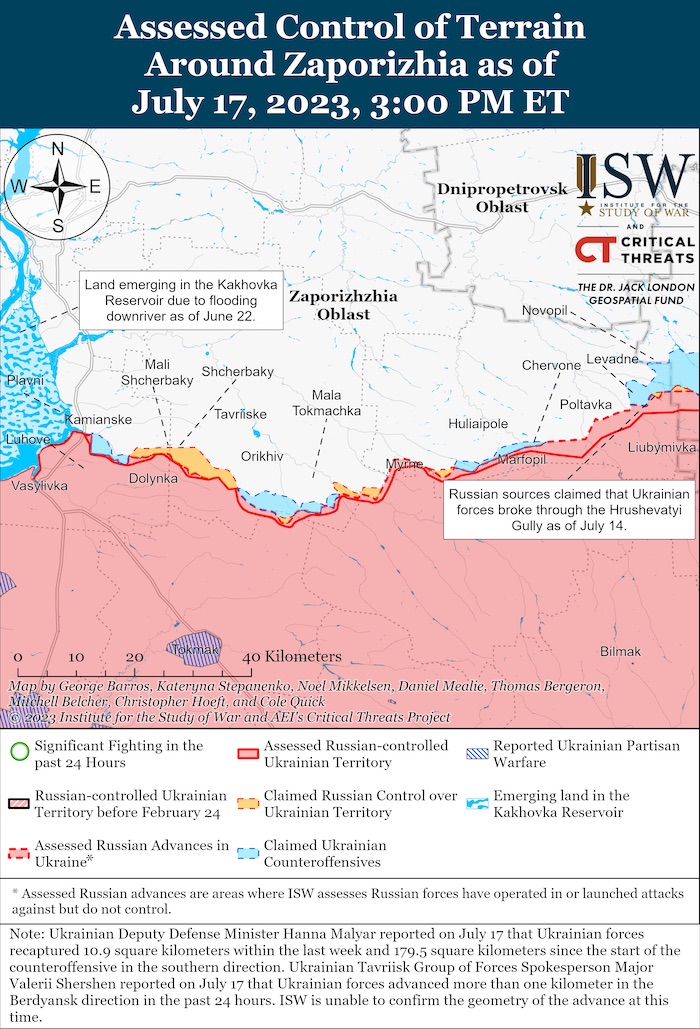
- Zaporizhzhia and Kherson axes: the adversary focuses its main efforts on preventing the further advance of Ukrainian troops. Russian forces launched an airstrike in the vicinity of Orikhiv (Zaporizhzhia oblast). The invaders fired artillery at more than 30 settlements, including Vil’ne Pole, Vremivka (Donetsk oblast), Zaliznychne, Verkhnya Tersa, Huliaipilske, Preobrazhenka, Bilohir’ya (Zaporizhzhia oblast), Mykhailivka, Novoberyslav, Mykil’s’ke, Inzhenerne, Kizomys (Kherson oblast), and the city of Kherson. Ochakiv (Mykolaiv oblast), was also hit. At the same time, the Ukrainian Defense Forces continue to conduct the offensive operation on Melitopol’ and Berdyans’k axes, consolidating their positions, and conducting counter-battery fire.
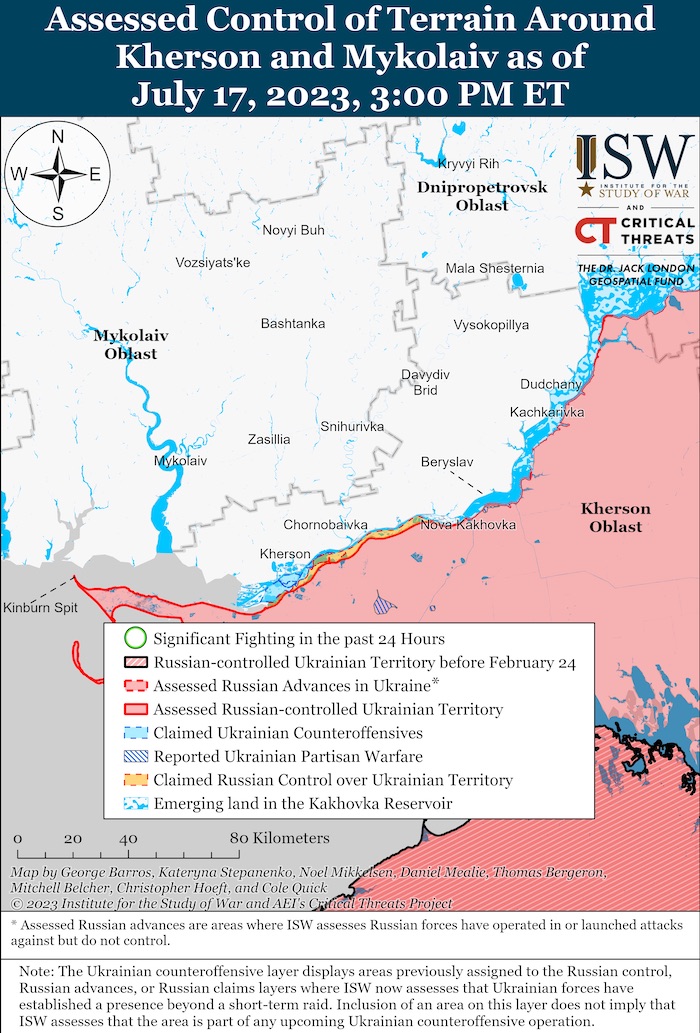
Military Updates
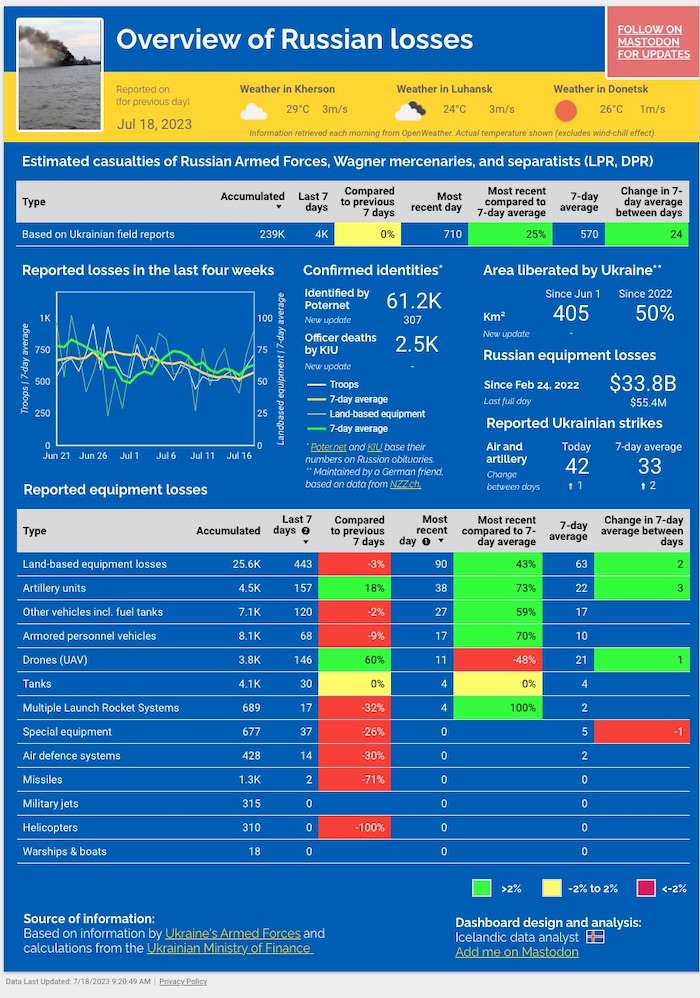
- Over the last week, fighting has continued in multiple sectors of the front, with both sides achieving marginal advances in different areas.
- In the north-east, Russian forces have attempted to push west through forests west of Kremina. Ukraine continues to resource significant effort around Russian-held Bakhmut. Here Russian forces are likely fragile but holding for now. Further south in Donetsk Oblast, especially around Avdiivka, Russian forces continue to attempt local assaults, with little success.
- In the south, Ukraine continues to attack on at least two axes, but is unlikely to have yet broken into Russia’s primary defensive lines. In this area, Russia has likely implemented a shell-rationing regime for artillery in an attempt to preserve its critical indirect fire capability. In Kherson Oblast, Ukraine maintains a small bridgehead on the left bank of the Dnipro River near the ruined Antonivsky Bridge which is an added challenge for Russian commanders who are likely concerned about the vulnerability of their south-western flank.
- After being sacked as commander of Russia’s 58th Combined Arms Army (58 CAA) in Ukraine, General-Major Ivan Popov claimed that one of his key complaints had been about the lack of counter battery provision.
- Russian ground forces survivability relies on effectively detecting Ukrainian artillery and striking against it, often with its force’s own artillery. A key component of this approach is counter-battery radars, which allow commanders to rapidly locate enemy gun lines.
- Russia is suffering from a worsening shortage of counter-battery radars, especially its modern ZOOPARK-1M. Only a handful of the originally deployed ZOOPARK fleet are likely to remain operational in Ukraine. Open-source footage showed another ZOOPARK being destroyed near the 58 CAA’s area in early July 2023. The priority Popov apparently gave to this problem highlights the continued centrality of artillery in the war.
Losses of the Russian army
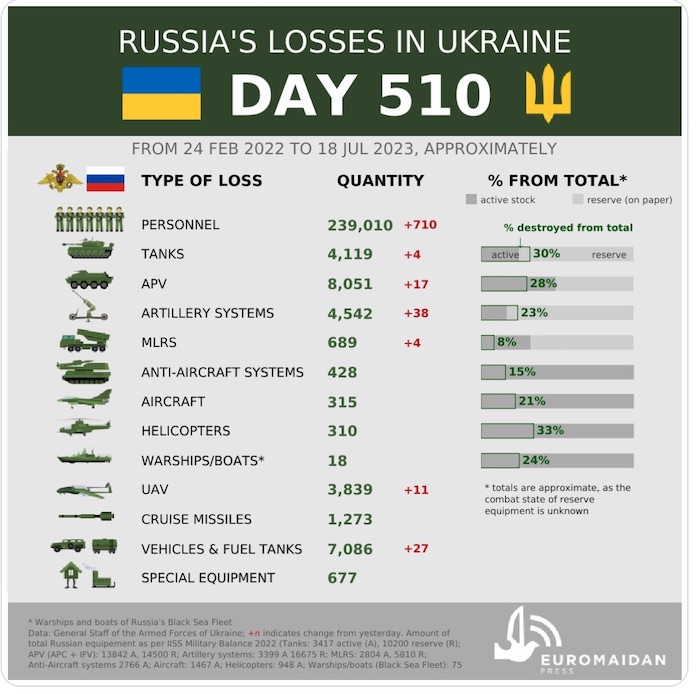
- Personnel – about 239010 (+710)
- Tanks – 4119 (+4)
- Armoured combat vehicles – 8051 (+17)
- Artillery systems – 4542 (+38)
- Multiple rocket launchers –MLRS - 689 (+4)
- Air defence means – 428 (+0)
- Aircraft - 315 (+0)
- Helicopters - 310 (+0)
- Automotive technology and fuel tanks – 7086 (+27)
- Vessels/boats - 18 (+0)
- UAV operational and tactical level – 3839 (+11)
- Special equipment – 677 (+0)
- Mobile SRBM system – 4 (+0)
- Cruise missiles – 1273 (+0)
Humanitarian
UN: More than 6.3 million Ukrainians are refugees, Ukrinform reports. "Currently, more than 6.3 million Ukrainians are refugees and an estimated 5.1 million are internally displaced, Rosemary DiCarlo, Under-Secretary-General for Political and Peacebuilding Affairs, said at the UN Security Council meeting. As noted, about 4.75 million Ukrainians have returned to their homes, including 1.1 million from abroad, since the beginning of the war. While most of many refugees and internally displaced persons want to return to their places of origin, voluntary return in safety and dignity will not be possible for many, given the current security situation, the diplomat noted. DiCarlo added that Ukraine has become one of the most heavily mined countries in the world, so the UN provides significant support for removing explosive devices from the country's territory.” About 3.7 million Ukrainians cannot get humanitarian aid because of Russia, Ukrinform reports. “The UN and humanitarian partners continue to respond to the dire consequences of the war, having reached over five million people with aid so far this year. There have been over 65 inter-agency convoys this year to frontline areas, Rosemary DiCarlo, Under-Secretary-General for Political and Peacebuilding Affairs, said at the UN Security Council meeting on July 17. At the same time, she emphasized that Russia continued to obstruct the work of humanitarian agencies. Unfortunately, the continuing lack of humanitarian access to the Russian-controlled areas of Donetsk, Luhansk, Zaporizhzhia and Kherson regions deprives an estimated 3.7 million people of much-needed assistance, the diplomat said.” Russia announces withdrawing security guarantees under grain deal, Ukrainska Pravda reports, citing European Pravda, quoting the Ministry of Foreign Affairs of the Russian Federation. “The Ministry of Foreign Affairs of the Russian Federation has announced the withdrawal of shipping safety guarantees within the framework of the Black Sea Grain Initiative, which ceased to operate as of Monday, 17 July. The Russian Foreign Ministry announced that the Russian Federation is closing the maritime humanitarian corridor in the northwestern waters of the Black Sea and, accordingly, restoring the regime of a temporarily dangerous area there. The Russian side explained its decision by the fact that contrary to the declared humanitarian goals, the export of Ukrainian food was almost immediately transferred to a purely commercial basis. The Ministry of Foreign Affairs of the Russian Federation is demanding the lifting of Western sanctions on Russian fertilisers and food in exchange for the continuation of the "grain agreement". Only upon receiving concrete results, and not promises and assurances, will Russia be ready to consider renewing the agreement. On 17 July, the Russian president’s press secretary Dmitry Peskov announced the suspension of the Black Sea Grain Initiative.” Russia ignored UN proposal to connect "daughter" of "Rosilkhozbank" to SWIFT, - Guterres, Censor.net reports, citing the UN website. “In a letter to the Russian dictator Vladimir Putin, the Secretary General of the United Nations, Antonio Guterres, proposed to connect the "daughter" of the sanctioned Rosilkhozbank to the SWIFT system in order to continue the "grain agreement". But Russia did not respond to this offer. Russia raised the issue of connecting Rossilhospbank to the SWIFT system as a key condition for the possible extension of the "grain agreement". The UN recently reached a concrete decision with the European Commission to allow the Rosilkhozbank subsidiary to regain access to SWIFT, Guterres said. He noted that such a proposal could be implemented within the existing norms. I am deeply disappointed that my proposals were ignored, Guterres added.” 200 children to be evacuated from Kharkiv Oblast due to danger, Ukrainska Pravda reports, citing Oleh Syniehubov, Head of the Kharkiv Oblast Military Administration. "Recently, a decision was taken at the Defence Council regarding the mandatory evacuation of children from nine settlements in the Vovchansk territorial hromada. We need to evacuate 194 children. They will initially be evacuated to the city of Kharkiv, and later we will ask people where they would like to go next. Our priority is evacuating people beyond the borders of Kharkiv Oblast, but people do not want to go further than the city of Kharkiv. We have accommodation reserved not only in Kharkiv, but in other oblasts too - Poltava, Rivne and other oblasts [of Ukraine]. Syniehubov stated that "people are reluctant to evacuate. But safety is the priority, he said. These settlements are attacked every day. This morning the Russians shelled the city of Vovchansk, injuring one person. They launch attacks using not just S-300 systems but all types of weaponry, especially since the front line lies along the Kupiansk area, he added.”Environmental
Ukraine has recorded about 2,500 cases of environmental damage during first 500 days of full-scale war, Ministry of Environmental Protection and Natural Resources of Ukraine reports. “In 500 days since the full-scale Russian invasion began, Ukraine has recorded about 2,500 cases of environmental damage estimated at over UAH 2 trillion (USD 56 bln). The most affected regions are Donetsk, with over UAH 666 billion in damages, Luhansk (with UAH 477 billion), and Kharkiv, with over UAH 361 billion in damages. These are not final figures, as the SEI experts cannot access occupied territories and can’t record and assess all environmental damage. As Minister Ruslan Strilets noted: “Every day we lose people, resources, and natural wealth. Every day inspectors from the State Environmental Inspection of Ukraine record environmental destruction caused by hostilities. The numbers are horrifying. Today we have already recorded about 51 billion euros or 2 trillion hryvnias in environmental damage. This means that every day of the war costs Russia at least 102 million euros or 4 billion hryvnias in environmental damage. The assessment is ongoing. Russia will pay for every day of this war.” Russians continue to mine ZNPP, - Kotin, Censor.net reports, citing Petro Kotin, the president of Energoatom State Enterprise, with reference to Energoatom. "The Russian occupiers continue to use it as their military base. We regularly receive reports that they mine our station, Kotin said, clarifying that the radiation status at the ZNPP site is currently monitored thanks to radiation monitoring sensors located 5 km from the station on the right bank of the Dnieper. In addition, IAEA inspectors are present at the ZNPP, and their information helps to understand what is happening at the nuclear facility. However, the occupiers do not allow the representatives of the Agency to all areas that need to be inspected. […] Earlier, Kotin reported that there are about 700 occupiers at the station.”Legal
UK Announces New Sanctions over Russia's Forced Deportation of Ukrainian Children, European Pravda reports. “According to James Cleverly, UK Foreign Secretary, London has announced 14 new sanctions in response to Russia's attempts to destroy Ukrainian national identity, including 11 against those involved in the forced deportation of Ukrainian children. It is noted that Russian officials can expect asset freezes and travel bans due to their involvement in the forced deportation of Ukrainian children and the spread of hate-fueled propaganda. […] In his chilling programme of forced child deportation, and the hate-filled propaganda spewed by his lackeys, we see Putin's true intention – to wipe Ukraine from the map, emphasised Cleverly. Previously, in June 2022, the UK imposed sanctions against Russian Children's Rights Commissioner Maria Lvova-Belova for her alleged involvement in the forced displacement and adoption of Ukrainian children. In March, the Pre-Trial Chamber II of the International Criminal Court issued arrest warrants for Russian President Vladimir Putin and Maria Lvova-Belova, who is also the authorised representative of the Russian President on children's rights, accusing them of war crimes related to the illegal deportation and transfer of Ukrainian children. According to some estimates, Russia has abducted 700,000 children from the temporarily occupied territories of Ukraine. The Ukrainian authorities claim that only 307 have been returned.»Support
Reznikov on Ramstein-14 meeting: We will continue to do impossible, Censor.net reports, citing Defense Minister Oleksiy Reznikov in a column for LIGA.net. “Tomorrow, July 18, another meeting will be held in the Ramstein format, which was created to provide military assistance to Ukraine from partners and allies. On July 18, we will continue to do the impossible at another meeting in the Ramstein format, Reznikov stressed. The minister recalled that regarding each type of foreign weaponry that has been at the front for a long time, he initially heard "no, it won't happen, it's impossible." Actually, it is possible, but in due time and under the condition of our persistence, the minister said.” US gives ‘green light’ to European countries to train Ukrainians on F-16 fighter jets, Biden official says, CNN reports. “The US will allow European countries to train Ukrainians on F-16 fighter jets, a top Biden administration official confirmed Sunday, a potential boon for Ukraine’s efforts to counter Russia’s air superiority. The president has given a green light and we will allow, permit, support, facilitate and in fact provide the necessary tools for Ukrainians to begin being trained on F-16s, as soon as the Europeans are prepared, national security adviser Jake Sullivan told CNN’s Jake Tapper on “State of the Union.” The decision cements a stark turnaround for President Joe Biden, who said earlier this year that he did not believe that Ukraine needed the F-16s. One of the main issues Kyiv’s ground forces have faced as their counteroffensive gets underway is Russian air power holding them back. Russia still maintains air superiority, which makes it difficult for ground forces to advance. In May, Biden had informed G7 leaders that the US would support a joint effort with allies and partners to train Ukrainian pilots on fourth generation aircraft, including F-16s, though it was unclear at the time when that training would start. The US-made jet has air-to-air refueling capabilities and is compatible with most NATO weapons already being supplied to Ukraine. Despite first entering production in the 1980s, it has gone through several upgrades, making it more advanced and versatile that any jet Ukraine currently has in its fleet, and a fierce rival for most Russian aircraft, with the exception of newer models that Moscow has hesitated to deploy in Ukraine. Sullivan noted Sunday that European allies have said they need several weeks to prepare training abilities and that the US would meet whatever timeline they set out.” A Hundred Ex-Taiwanese Missile Launchers Could Transform Ukraine’s Air-Defences, Forbes reports. “The American-made HAWK surface-to-air missile system is more than 60 years old. But if reports are true, it’s about to become Ukraine’s main SAM. The backbone of the country’s air-defense network. It’s not a terrible outcome for Kyiv. The 1960s-vintage Raytheon MIM-23 Homing All-the-Way Killer is simple, reliable, highly mobile, easy to upgrade and works just fine against slower drones, cruise missiles and manned aircraft. As a bonus, the HAWK could be compatible with another, more modern SAM system that Ukraine uses: the US-Norwegian National Advanced Surface-to-Air Missile System, or NASAMS. […] Reportedly, the plan is for the United States to donate to Ukraine the hundred or so HAWK launchers plus missiles and associated equipment, including radars. The ex-Taiwanese launchers would complement the single large HAWK battery—six or more launchers plus a radar—that the United States and Spain already have pledged to the Ukrainian war effort. A big consignment of HAWKs would help Kyiv to resolve a looming crisis: the imminent depletion of missile stocks for its ex-Soviet S-300 and Buk SAMs. […] Ukrainian industry doesn’t produce missiles for the S-300 and Buk batteries. And there aren’t a lot of these missiles in the inventories of Kyiv’s foreign allies. It’s for that reason that NATO countries have pledged to Ukraine all the SAM systems they can spare: IRIS-Ts, Crotales, NASAMS, Patriots and others—nearly 20 batteries, in all. […] The HAWK is a medium-range SAM. Each 17-foot missile, fired by a launcher with three rounds, ranges around 30 miles. The missile homes in on energy from a ground-based radar reflecting from the airborne target. The dozen or so countries still deploying the HAWK value it for its simplicity, compactness—a single heavylift helicopter can haul a launcher—and upgradability. Indeed, Norwegian firm Kongsberg—builder of the NASAMS—has developed a new digital command post for HAWK batteries that borrows its main components from NASAMS. That raises the possibility that the Ukrainian air force might, with some effort, be able to combine its NASAMS and HAWK batteries into a single force using the same radars and command posts.” Editorial: A smart NATO would seek Ukraine’s accession, The Kyiv Independent concluded days before the NATO Summit. “When one looks at the history of the West supporting Ukraine in the fight against Russia, one pattern shines through: missed opportunities. The whole war is ripe with opportunity for NATO. The alliance’s loyal ally, Ukraine, fights against the alliance’s main security threat, Russia, bleeding it weaker day by day. For that, NATO members pay only with money and weapons – and don’t have to spill a single drop of their soldiers’ blood. One could see it as the best possible deal. But if NATO members see it like that, they don’t show it. Instead of pumping Ukraine up with Western weapons and enabling it to strike a quick and humiliating blow to Russia, Western powers, notably in the EU, have been dragging their feet at many opportunities. A new investigation, just published by the Kyiv Independent and partners, traces the shockingly slow and reluctant response that EU members have had to the ammunition shortage caused by the Russian invasion. EU countries waited for weeks before sending any aid in the beginning of the full-scale war, evidently waiting to see whether Ukraine would fall. That could be dismissed as the fog of shock at the beginning of the invasion. But a year and a half later, the same countries have been unable to do anything about their dwindling ammunition stocks – leading to a critical shortage of basic ammunition on the battlefield in Ukraine, and impeding its counteroffensive. Last year, whenever Ukraine had a breakthrough – like the counteroffensives in Kharkiv and Kherson regions – it didn’t have enough weapons to capitalize on these victories and cause an avalanche effect, crumbling the Russians further. Every new type of weapons pledged by the West has come after months of Ukraine pleading for it and the allies rejecting the pleas – until finally agreeing to provide it. Because of this hesitancy, Ukraine has entered the 2023 counter-offensive weaker than it could be, and still doesn’t have the fighter jets that it has been pleading for many months. It appears that the West treats Ukraine’s requests as unreasonable demands. While in fact, Ukraine is simply showing its allies a list of the most crucial tools it needs to survive – and by surviving, protect the West. Ukraine is asking its allies for more weapons and better weapons not because it wants to have it easier in the war against Russia, but because it needs them to survive. It’s in NATO’s utmost interests that Ukraine wins, and Russia loses. It’s in NATO’s interests not to just grudgingly accept Ukraine’s accession – a smart alliance would actively seek Ukraine’s accession as soon as possible. Accepting it would mean strengthening the alliance with the only member whose military has vast battlefield experience. […]” All NATO countries support Ukraine’s membership, but accession is impossible during the war – Morawiecki, Censor.net reports, citing a podcast with Polish Prime Minister Mateusz Morawiecki. “Despite the fact that Ukraine did not receive an invitation, historic decisions were made at the NATO summit in Vilnius. All NATO members agree that Ukraine will become a member of the Alliance, but this is not possible in times of war. We need to support Ukraine's Western aspirations. A free and sovereign Ukraine, and eventually a member of NATO's eastern flank, is how we see the future of our part of Europe, and this vision is shared by other leaders of the Alliance, Morawiecki said. But, he adds, while the war is ongoing, making concrete decisions on Ukraine's accession to NATO would be like reading coffee grounds. However, in his opinion, the decisions of the Vilnius summit are still historic. NATO countries are finally waking up from a long geopolitical sleep. Russia's aggression against Ukraine has also finally ended the post-Cold War era, and today it is clear to everyone that the protection of the world order, the security of Western civilization and the free world requires concrete actions, not just a roundtable discussion, Morawiecki summarized.”New Developments
- We cannot allow war in Ukraine to last another 500 days – UK at UN, Ukrainska Pravda reports, citing UK Foreign Secretary James Cleverly speechat a meeting of the UN Security Council in New York. "We cannot allow this war to go on for another 500 days. Cleverly recalled that the UN General Assembly has repeatedly called for peace based on the principles of he UN Charter, as well as the shared belief that might does not equal right. "President Zelenskyy’s 10-point peace plan shows the way forward. Ukraine wants peace. We want peace. The whole world wants peace. He emphasised that a just and durable peace is what the international community is seeking, and Russia should make this choice today by withdrawing all its troops from Ukraine.”
- There will be a response: Putin threatens to retaliate for Crimean Bridge attack, Ukrainska Pravda “Russian President Vladimir Putin has said that Russia will retaliate for the Crimean Bridge attack. […] The Ministry of Defence is preparing suitable measures. Putin also said that the attack on the bridge was "insignificant" because it has not been used to transport weapons and ammunition for a long time. He also stressed that he believes the attack on the bridge to be a terrorist attack.”
- Russia’s Medvedev calls for 'inhumane' response to Crimean Bridge attack, TASS reports, citing Dmitry Medvedev, the deputy chairman of Russia’s Security Council. "The global track record and our own experience show that there is no using international sanctions or issuing warnings against terrorists. They understand only the language of force. Only targeted and quite inhumane steps [should be taken], Medvedev wrote on his Telegram channel. Therefore, Medvedev continued, their own homes and the houses of their relatives should be blown up as he called for efforts to search for and wipe out their accomplices. He dismissed the idea of trying the perpetrators as dull. Eliminating the supreme commanders of terrorist units is key, the politician said, describing the mission as difficult but possible."
- Ukrainian Foreign Minister reacts to attack on Crimean Bridge, Ukrainska Pravda reports, citing CBS. “Dmytro Kuleba, the Minister of Foreign Affairs of Ukraine, has commented on the attack on the Crimean (Kerch) Bridge which took place on the night of Monday, 17 July. The Ukrainian minister said that he learned about the incident from the news and added that he has no official information. The truth is that one broken Russian bridge means fewer broken Ukrainian lives. He recalled that Russia had been using this bridge to supply the Russian army in occupied Crimea and the occupied territories in Ukraine's south with additional resources.”
- Britain rejects Russia's accusation of UK's possible involvement in Crimean bridge attack, Reuters “Britain rejected accusations by Russia on Monday that British intelligence services might have been involved in an attack on Russia's bridge to Crimea. This is baseless speculation from Russia, and we will not dignify it by commenting further, a spokesperson for Britain's foreign ministry said in emailed comments. Russia's deputy UN ambassador, Dmitry Polyanskiy, said on Monday, without providing any evidence, that British intelligence services might have been involved in the attack.”
- Details about Crimean Bridge damage to be available soon, says Cabinet, TASS “The information about the scale of the damage done to the Crimean Bridge roadway in Monday's attack will be available soon, the Russian government said in a statement on its website. [...] Last night, two Ukrainian unmanned aerial vehicles carried out a terror attack on the Crimean Bridge, Russia’s National Antiterrorism Committee told TASS. […] Though the attack halted traffic on the bridge, the railway service has already been restored, and the ferry service is available, too. Passenger cars will be able to depart from Crimea by ferry service, while truck drivers are urged to take bypass routes via the new Russian regions.”
- Kremlin announces termination of Black Sea Grain Initiative, Ukrainska Pravda “On 17 July, the Russian president’s press secretary Dmitry Peskov announced the suspension of the Black Sea Grain Initiative. […] Peskov said the reason for the termination of the agreement was that the part of the agreement concerning Russia has not been fulfilled. He said that as soon as the Russian part of the agreement is fulfilled, Russia will immediately return to the implementation of the agreement.”
- White House on Russia’s disruption of grain agreement: It will harm millions of vulnerable people around world, net reports, citing European Pravda. “Russia’s withdrawal from the grain deal will worsen food security and harm millions of vulnerable people around the world. This was stated by the spokesman of the National Security Council of the United States, Adam Hodge. The Black Sea Grain Initiative was crucial to reducing food prices around the world, which rose sharply as a result of Russia's brutal and unprovoked invasion of Ukraine, Hodge emphasized. He also noted that more than half of the 32 million tons of grain and food shipped under the agreement went to developing countries, including some of the world's most food-insecure regions. Hodge pointed out that every shipment under the agreement has helped to reduce hardship in the world's poorest countries, as access to world markets lowers food prices for everyone."
- US will continue to work with other countries to ensure movement of Ukrainian grain, Reuters ”The United States will continue to work with other countries to ensure movement of grain out of Ukraine after Russia halted participation on Monday in the year-old UN-brokered deal that allows its neighbor to export grain through the Black Sea, White House National Security Council spokesman John Kirby said on Monday. […] The United States is not considering using US military assets to help protect grain shipments, Kirby said.”
- Ukraine's Foreign Minister: Russia Has Been Slowly Killing "Grain Deal", European Pravda “Ukrainian Minister of Foreign Affairs, Dmytro Kuleba, commenting on Russia's withdrawal from the "grain deal," stated that Russia is using hunger as an instrument. Russia has been killing the 'grain initiative' from one extension to another. You have to know that last year when the Black Sea grain initiative was introduced, grain prices in the world dropped by 20%. The non-extension of the agreement means that prices for grain all across the world will go up, noted the Ukrainian Foreign Minister in an interview with CBS. He pointed out that regions such as Africa and Asia will feel the impact of this price increase, and it is the result of Russia's actions. According to him, Russia uses hunger as an instrument to blackmail the entire world and pursue its commercial interests. Kuleba called on Russia to stop playing hunger games."
Assessment
- On the war.
The Institute for the Study of War has made the following assessment as of July 17, 2022:
Russian forces conducted active offensive operations along the Kupiansk-Svatove line and have likely made marginal tactical gains in this direction as of July 17. Ukrainian Deputy Defense Minister Hanna Maliar stated that Russian forces have been advancing in the Kupiansk direction since the end of last week and are attacking Ukrainian positions near Masyutivka (13km northeast of Kupiansk) and Novoselivske (14km northwest of Svatove) in order to push Ukrainian forces across the Oskil River. The Ukrainian General Staff reported that Russian forces conducted unsuccessful offensive operations south of Masyutivka, and a Russian milblogger claimed that Russian forces have advanced up to one to two kilometers in the Kupiansk direction. Another Russian milblogger claimed that elements of the 21st Motorized Rifle Brigade (2nd Combined Arms Army, Central Military District) and “Storm-Z” assault units attacked Ukrainian positions near Karmazynivka (13km southwest of Svatove) and took control of two Ukrainian strongholds northwest of Novovodyane (15km southwest of Svatove). ISW previously observed that Russian forces were drawing “Storm-Z” assault units to the Kharkiv-Luhansk Oblast border area over the past month, and it appears as though Russian forces have launched small-scale localized offensives in this sector using “Storm-Z” elements in order to try and take advantage of Ukraine’s operational focus elsewhere along the front. ISW previously assessed that “Storm-Z” units are largely ineffective in pursuing more than small-scale, tactical breakthroughs, and the launch of Russian offensive operations on this front is unlikely to capture significant territory due to the force composition and capacity of the Russian grouping in this area.
Russian forces continued limited ground attacks southwest and south of Kreminna on July 17. The Ukrainian General Staff reported that Russian troops conducted unsuccessful offensive actions west of Dibrova (6km southwest of Kreminna) and east of Vesele (30km due south of Kreminna), and Maliar also noted that Russian forces continued unsuccessful attacks in the Serebrianske forest area (about 10km southwest of Kreminna). Russian milbloggers emphasized that Ukrainian troops are trying to defend against Russian attacks near Torske (15km west of Kreminna), and one milblogger claimed that Ukrainian forces are conducting reconnaissance in small groups in the forest areas west of Kreminna.
Russian forces continued ground attacks around Bakhmut but did not make any confirmed gains in the area on July 17. The Ukrainian General Staff reported that Russian forces conducted unsuccessful ground attacks near Orikhovo-Vasylivka (11km northwest of Bakhmut), Hryhorivka (8km northwest of Bakhmut), Ivanivske (6km west of Bakhmut), Kurdiumivka (12km southwest of Bakhmut), and Bohdanivka (5km northwest of Bakhmut). Russian sources also claimed that Russian forces are drawing reserves to Bakhmut and counterattacking on the flanks in order to restore lost positions. A Russian milblogger claimed on July 16 that Russian forces have been attacking Ukrainian forces on the northern flank of Bakhmut from the Berkhivka direction for the last five days and that Russian forces, including the 200th Motorized Rifle Brigade (14th Army Corps, Northern Fleet) and unspecified BARS (Russian Combat Reserves) and airborne (VDV) units, engaged with Ukrainian forces in the direction of Yahidne (2km north of Bakhmut). Footage published by the Russian Ministry of Defense (MoD) on July 17 purportedly shows unspecified VDV units using flamethrowers to repel Ukrainian forces attempting to enter the outskirts of Bakhmut. A Russian milblogger claimed that elements of the Russian 106th Guards VDV Division counterattacked Ukrainian forces attempting to storm a stronghold west of Klishchiivka (7km southwest of Bakhmut) and claimed the Ukrainian forces were taking advantage of the command-and-control repercussions resulting from recent command changes in the Russian 106th Guards VDV Division. The milblogger claimed elements of the 72nd Motorized Rifle Brigade (3rd Army Corps) and the 57th Motorized Rifle Brigade (5th Combined Arms Army, Eastern Military District) have prevented Ukrainian forces from occupying the higher ground near Klishchiivka and that Russian BARS units from Kreminna have arrived as reinforcements. Another milblogger claimed that Chechen “Akhmat” forces are also fighting near Klishchiivka.
Ukrainian forces continued counteroffensive operations in the Bakhmut area on July 17 and have likely made limited gains. Ukrainian Deputy Defense Minister Hanna Maliar stated that Ukrainian forces have advanced in unspecified locations on the southern flank of Bakhmut. Wagner commander “Lotos” stated in an interview with a Wagner-affiliated milblogger that Ukrainian forces captured a stronghold north of Klishchiivka and have established fire control over the settlement. Lotos claimed Ukrainian forces also control areas north of Bakhmut near Zaliznianske (9km northwest of Bakhmut), the Berkhivske reservoir (4km northwest of Bakhmut), an unspecified section of the railway north of Bakhmut, ground lines of communication (GLOCs) along the Chasiv-Yar Khromove route, and the heights around Klishchiivka. Lotos reported that Ukrainian forces are trying to capture Yakovlivka (14km northeast of Bakhmut) in order to interdict Russian lines of communication to Soledar (12km northeast of Bakhmut), where heavy fighting is ongoing. Another milblogger claimed that Ukrainian forces unsuccessfully attempted to break into Klishchiivka from the west and northwest but that Ukrainian forces regained lost positions in the Orikhovo-Vasylivka area near the E40 (Bakhmut-Sloviansk) highway.
Russian forces continued ground attacks along the Avdiivka-Donetsk City line on July 17. The Ukrainian General Staff reported that Russian forces unsuccessfully attacked Ukrainian forces near Avdiivka (north of Donetsk City) and Krasnohorivka (on the northwestern outskirts of Donetsk City). A Russian milblogger claimed that Russian forces unsuccessfully attacked Ukrainian forces near Novomykhailivka (just southwest of Donetsk city), Marinka, and Pervomaiske (on the northwestern outskirts of Donetsk city). […]
Ukrainian forces continued ground attacks and advanced near the Donetsk-Zaporizhzhia administrative border on July 17. Geolocated footage posted on July 17 shows Ukrainian forces reaching the outskirts of Staromayorske (about 8km south of Velyka Novosilka), before Russian active elastic defensive maneuvers pushed them back to previous lines. A Russian milblogger claimed that Ukrainian troops captured positions on the outskirts of Staromayorske, and another Russian source reported that heavy fighting is ongoing in the vicinity of Staromayorske but that Russian forces control the settlement itself. Ukrainian Deputy Defense Minister Hanna Maliar reported that Ukrainian troops continue successful counteroffensive operations in the Berdiansk (western Donetsk-eastern Zaporizhzhia oblast) direction, specifically south of Velyka Novosilka near Makarivka, Staromayorske, and Novodarivka.
Russian forces conducted limited counterattacks in western Donetsk Oblast on July 17. The Ukrainian General Staff reported that Russian forces attacked towards northern Staromayorske. A Russian milblogger claimed that Russian forces managed to successfully regain lost positions near Pryyutne (14km southwest of Velyka Novosilka).
Russian sources claimed that Ukrainian forces continued unsuccessful ground attacks in the Orikhiv area in western Zaporizhzhia Oblast on July 17. A Russian milblogger claimed that Ukrainian forces unsuccessfully attacked towards Robotyne (15km south of Orikhiv), and another milblogger noted that the pace of hostilities in this sector of the front has generally decreased and that Ukrainian troops are increasingly operating in small sabotage and reconnaissance groups. Russian milbloggers additionally claimed that Russian forces repelled a Ukrainian attack near Pyatykhatky (25km southwest of Orikhiv).
The July 17 attack on the Kerch Strait Bridge will likely have continuing ramifications on Russian logistics in southern Ukraine. Russian authorities accused Ukrainian special services of conducting an unmanned surface vehicle strike against the Kerch Strait Bridge between Russia and occupied Crimea on the morning of July 17. Footage of the aftermath shows that one Kerch Strait Bridge Road span had collapsed and another span suffered damage but remains intact. The Russian Ministry of Transport claimed that the strikes did not damage the rail bridge or supports of the road bridge, and rail traffic across the Kerch Strait Bridge resumed several hours after the strike. Russian occupation authorities rerouted heavy civilian traffic from occupied Crimea to Russia through occupied southern Ukraine, and Russian sources reported extensive traffic jams in Crimea’s Dzhankoi Raion and occupied Kherson Oblast towards Melitopol. Russian tourists fleeing occupied Crimea likely exacerbated traffic and likely impeded Russian logistics from Crimea to rear areas in Zaporizhzhia and Kherson oblasts. Occupation authorities asked civilians to consider alternate evacuation routes to mitigate the immediate traffic issues. Ukrainian Main Military Intelligence Directorate (GUR) Spokesperson Andrii Yusov declined to comment on Ukrainian involvement in the incident. The Kerch Strait Bridge and military areas in occupied Crimea are legitimate military targets for Ukrainian forces in their defense against the full-scale Russian invasion and occupation of Ukraine, as ISW and Ukrainian officials have previously reported.
The Russian government’s continued failure to put Russian society on a war-time footing will have significant impacts on Russian logistics as traffic from Russian tourism to occupied Crimea jams Russian logistics to southern Ukraine in the midst of the ongoing Ukrainian counteroffensive in the south. The Kerch Strait Bridge is along one of two ground lines of communication (GLOCs) supporting Russia’s southern force grouping, with the other route passing through occupied Donetsk, Zaporizhzhia, and Kherson oblasts. This sole remaining logistics route is now a single point of failure for the supply of the large numbers of mechanized Russian forces in southern Ukraine needed to resist Ukrainian counteroffensives. Russian and occupation officials have nevertheless continued to promote occupied Crimea as a tourist destination, however, urging Russian civilians to drive through and to a warzone rather than advising them to avoid it as a responsible government would. Russian occupation authorities recently struggled to mitigate traffic issues just from increased Russian tourism across the Kerch Strait Bridge, as ISW has previously reported. Russian President Vladimir Putin even ordered the use of Russian military assets to ferry tourists across the Kerch Strait. Some Russian milbloggers also suggested that the attack against the Kerch Strait Bridge should not reduce continued tourist flows.
Russian logistics to southern Ukraine will likely suffer in the short and medium-term, likely exacerbating recent and significant complaints about inadequate Russian supplies in southern Ukraine. Former Russian 58th Combined Arms Army (Southern Military District) Commander Major General Ivan Popov’s recent complaints about the Russian military command’s mistreatment of Russian forces defending against the Ukrainian counteroffensive in southern Ukraine sparked great ire in the Russian information space. Many of Popov’s complaints indicated that the 58th Combined Arms Army, and likely other Russian formations deployed in Zaporizhzhia Oblast, suffer from supply shortages that will further worsen if tourist and other civilian traffic slow down logistics routes supporting Russian forces in southern Ukraine. Further issues with support for this grouping, and further resulting complaints that emerge in the Russian information space, are likely to draw further outrage from the Russian ultranationalist community and undermine confidence in the Russian Ministry of Defense (MoD).
Russian and occupation authorities appear to be consumed with mitigating the consequences of the attack rather than leveraging the incident to levy heavy informational attacks with rhetorical inflections. Russian President Vladimir Putin held a meeting instructing Russian Deputy Prime Minister Marat Khusnullin to lead a headquarters and develop solutions to mitigate traffic issues across the bridge. Khusnullin and other occupation authorities decided to lift curfews and passport checks along major highways to Russia in occupied territories, which are under Russian martial law, in order to mitigate some of these traffic issues. Putin’s and other senior Russian officials’ statements were largely straightforward; the officials accused Ukraine of conducting a “terrorist attack” and promised retaliation, which is consistent with prior official reactions to claimed Ukrainian provocations. The Russian Foreign Ministry accused Ukraine of conducting the strike in conjunction with American and British intelligence, forwarding a consistent Russian narrative aimed at falsely portraying Russia as at war with the West rather than Ukraine. Some Russian officials connected the Kerch Strait Bridge attack to the Black Sea Grain Initiative, which expired today. Senior Russian officials, including Putin, had signaled before the bridge was attacked that Russia was unwilling to renew the grain deal without significant additional concessions, however. Russia was very unlikely to have engaged in negotiations around the continuation of the grain deal or any other negotiations with Ukraine in good faith, as ISW has previously assessed.
The Russian milblogger response to the Kerch Strait Bridge attack largely criticized Russian authorities for failing to secure the bridge. Some milbloggers, including former Russian officer and critical pro-war nationalist Igor Girkin, offered the critique that Russian authorities have focused too heavily on road security and not enough on maritime security, thereby allowing the most recent attack on the bridge to occur. Girkin complained that the Russian border officials have devoted too much time to checking civilian cars entering the bridge and not enough time investing in infrastructure that could protect against attacks launched by sea. […]
The Wagner Group continues to prepare to establish a permanent presence in Belarus. Independent Belarusian monitoring group “The Hajun Project” reported on July 17 that another Wagner vehicle convoy traveled towards the Tsel village tent camp near Asipovichy, Mogilev Oblast, Belarus, and that two other Wagner columns had traveled along this same route between July 11 and July 17. Wagner-affiliated Telegram channels relatedly posted footage on July 17 of a Wagner column moving between Voronezh and Oryel oblasts before arriving at the training ground near Asipovichy. The Ukrainian Resistance Center reported that over 700 Wagner fighters have recently settled in the Tsel-Asipovichy area and that Belarusian authorities have formed three Belarusian special-purpose units to train under Wagner leadership in these training areas. Several Wagner-affiliated milbloggers additionally claimed that Wagner’s training ground in Molkino, Krasnodar Krai, will cease operations by July 30 and that Wagner will deploy elsewhere and they posted footage of Wagner fighters ceremoniously lowering Russian and Wagner flags at Molkino. Wagner fighters will likely continue to redeploy to Belarus from training areas in Molkino and staging grounds elsewhere in Russia over the coming month.
Russia continues efforts to reorganize its domestic security apparatus in the wake of the Wagner Group’s armed rebellion. Russian State Duma Deputy Alexander Khinshtein stated on July 17 that the “Grom” special units of the Russian Federal Drug Control Service (of the Russian Ministry of Internal Affairs) were officially transferred to the control of the Rosgvardia (Russian National Guard). Khinshtein emphasized that the decision was made to capitalize on Rosgvadia’s key role in protecting Russia’s internal security. ISW previously reported on July 4 that the decision to transfer “Grom” to Rosgvardia emphasizes the Kremlin’s desire to consolidate an effective anti-rebellion force under Rosgvardia command. The Russian Duma additionally announced on July 17 that it is considering a bill to allow Rosgvardia to field heavy weapons by amending the federal law “On the National Guard Troops of the Russian Federation,” which will allow the Rosgvardia to be armed with transport aircraft, combat, transport, and multi-purpose helicopters, infantry fighting vehicles, armored personnel carriers, communications complexes, boats, engineering equipment, and other military and paramilitary kit. The transfer of “Grom” units to Rosgvardia, as well as the decision to provide Rosgvardia with heavy combat equipment, supports ISW’s previous assessment that the Kremlin is continuing efforts to consolidate its internal security apparatus around Rosgvardia’s structures. However, several actors within the Russian internal security sphere have voiced their concern and dissatisfaction over the “Grom” transfer, and the reorganization of domestic security organs may cause more tension within Russia.
Ukrainian forces continued counteroffensive operations on at least three sectors of the front over the backdrop of increased Russian offensive operations along the Kharkiv-Luhansk Oblast border on July 17. Russian and Ukrainian sources reported that Russian forces have launched active offensive operations and advanced in the Kupiansk area (between northeastern Kharkiv Oblast and northwestern Luhansk Oblast) in the past several days. Russian forces likely are engaging in offensive operations in this area of the front in an effort to exploit Ukrainian operational focus on other sectors of the front and draw Ukrainian reserves away from critical areas of the theater, namely the Bakhmut and western Donetsk, and western Zaporizhzhia Oblast areas, where Ukrainian forces are pursuing counteroffensive operations. The poor quality and composition of Russian troops currently deployed on this line, however, will likely hinder Russia’s ability to achieve more than tactically significant gains or make an operationally significant breakthrough. Ukrainian and Russian sources have both reported the deployment of convict-formed “Storm-Z” assault units to the Kupiansk direction, and ISW has previously assessed that “Storm-Z” units have low operational effectiveness due to poor morale and discipline. Ukrainian forces also continued counteroffensive operations near Bakhmut, south of Velyka Novosilka, and near Orikhiv in western Zaporizhzhia Oblast throughout July 17.
Key Takeaways:
- The July 17 attack on the Kerch Strait Bridge will likely have significant and sustained impacts on Russian logistics as traffic from tourism to occupied Crimea jams Russian logistics to southern Ukraine in the midst of the ongoing Ukrainian counteroffensive in the south.
- Russian and occupation authorities appear to be consumed with mitigating the consequences of the attack rather than leveraging the incident to levy heavy informational attacks with rhetorical inflections.
- The Russian milblogger response to the Kerch Strait Bridge attack largely criticized Russian authorities for failing to secure the bridge.
- The Wagner Group continues to prepare to establish a permanent presence in Belarus.
- Russia continues efforts to reorganize its domestic security apparatus in the wake of the Wagner Group’s armed rebellion.
- Ukrainian forces continued counteroffensive operations on at least three sectors of the front over the backdrop of increased Russian offensive operations along the Kharkiv-Luhansk Oblast border on July 17.
- Russian forces conducted active offensive operations along the Kupiansk-Svatove line and have likely made marginal tactical gains in this direction.
- Russian forces continued limited ground attacks southwest and south of Kreminna, around Bakhmut, and along the Avdiivka-Donetsk City line.
- Ukrainian forces continued counteroffensive operations in the Bakhmut area and advanced near the Donetsk-Zaporizhzhia administrative border.
- Russian forces conducted limited counterattacks in western Donetsk Oblast.
- Russian sources claimed that Ukrainian forces continued unsuccessful ground attacks in the Orikhiv area in western Zaporizhzhia Oblast.
- Russian opposition outlet Verstka reported that Russian authorities have removed at least eight Russian military commanders without reappointing them to new positions since the start of the war, which is largely consistent with ISW’s previous assessments.
- Consequences and what to do?

